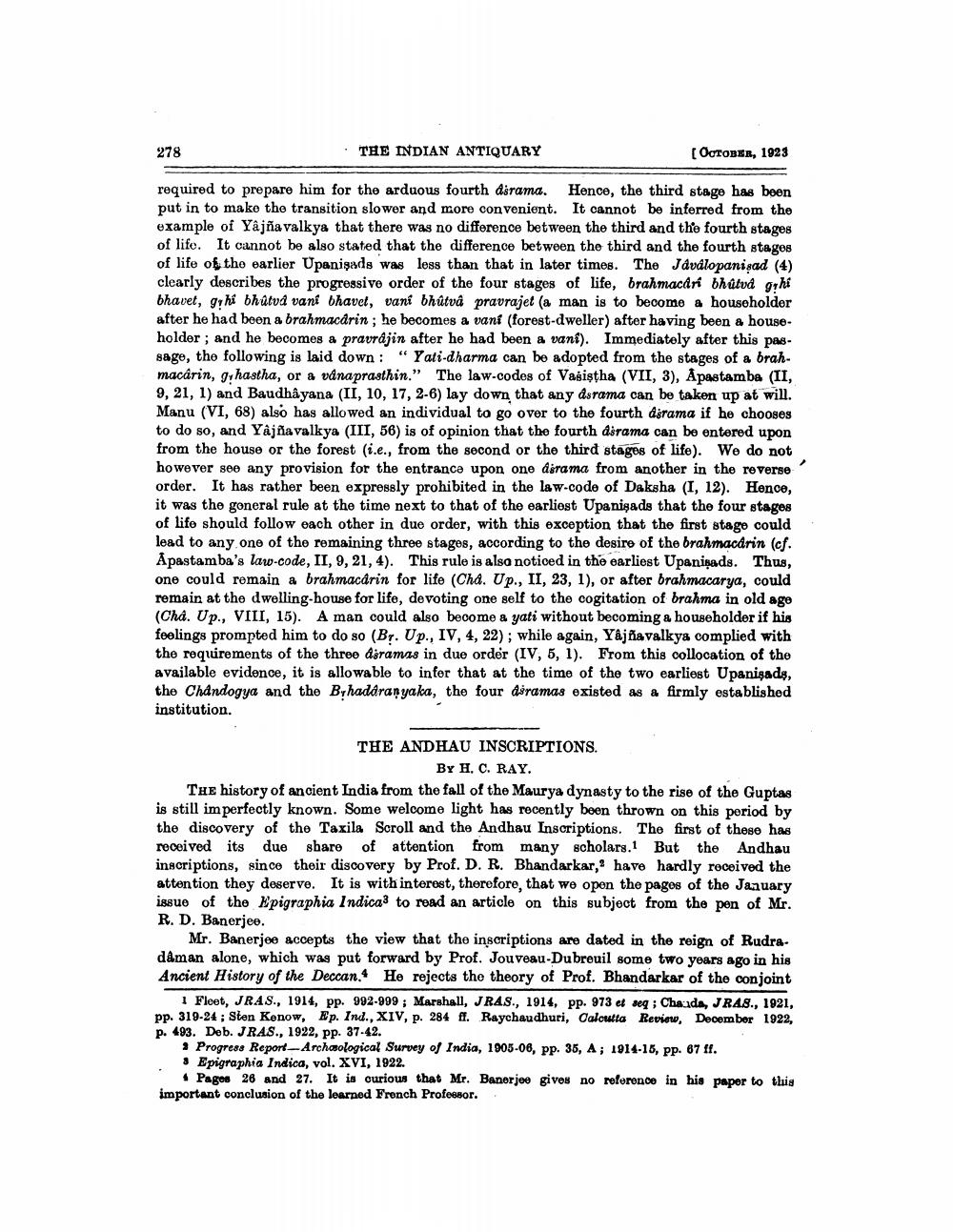________________
THE INDIAN ANTIQUARY
( Остовки, 1923
required to prepare him for the arduous fourth dsrama. Hence, the third stage has been put in to make the transition slower and more convenient. It cannot be inferred from the example of Yâjña valkya that there was no difference between the third and the fourth stages of life. It cannot be also stated that the difference between the third and the fourth stages of life of the earlier Upanisads was less than that in later times. The Jávalopanisad (4) clearly describes the progressive order of the four stages of life, brahmacari bhûtvá grhi bhavet, ghi bhûtvá vani bhavet, vani bhûtvâ pravrajet (a man is to become a householder after he had been a brahmacârin; he becomes a vaní (forest-dweller) after having been a householder; and he becomes a pravrájin after he had been a vaní). Immediately after this pas sage, the following is laid down: "Yati-dharma can be adopted from the stages of a brahmacârin, ghastha, or a vanaprasthin." The law-codes of Vasistha (VII, 3), Apastamba (II, 9, 21, 1) and Baudhâyana (II, 10, 17, 2-6) lay down that any dsrama can be taken up at will. Manu (VI, 68) also has allowed an individual to go over to the fourth dsrama if he chooses to do so, and Yajnavalkya (III, 56) is of opinion that the fourth dsrama can be entered upon from the house or the forest (i.e., from the second or the third stages of life). We do not however see any provision for the entrance upon one dirama from another in the reverse order. It has rather been expressly prohibited in the law-code of Daksha (I, 12). Hence, it was the general rule at the time next to that of the earliest Upanisads that the four stages of life should follow each other in due order, with this exception that the first stage could lead to any one of the remaining three stages, according to the desire of the brahmacárin (cf. Apastamba's law-code, II, 9, 21, 4). This rule is also noticed in the earliest Upanisads. Thus, one could remain a brahmacárin for life (Chd. Up., II, 23, 1), or after brahmacarya, could remain at the dwelling-house for life, devoting one self to the cogitation of brahma in old age (Châ. Up., VIII, 15). A man could also become a yati without becoming a householder if his feelings prompted him to do so (Br. Up., IV, 4, 22); while again, Yajnavalkya complied with the requirements of the three dsramas in due order (IV, 5, 1). From this collocation of the available evidence, it is allowable to infer that at the time of the two earliest Upanisads, the Chandogya and the Bṛhadaranyaka, the four diramas existed as a firmly established institution.
278
THE ANDHAU INSCRIPTIONS.
BY H. C. RAY.
THE history of ancient India from the fall of the Maurya dynasty to the rise of the Guptas is still imperfectly known. Some welcome light has recently been thrown on this period by the discovery of the Taxila Scroll and the Andhau Inscriptions. The first of these has received its due share of attention from many scholars.1 But the Andhau inscriptions, since their discovery by Prof. D. R. Bhandarkar, have hardly received the attention they deserve. It is with interest, therefore, that we open the pages of the January issue of the Epigraphia Indica3 to read an article on this subject from the pen of Mr. R. D. Banerjee.
Mr. Banerjee accepts the view that the inscriptions are dated in the reign of Rudradaman alone, which was put forward by Prof. Jouveau-Dubreuil some two years ago in his Ancient History of the Deccan. He rejects the theory of Prof. Bhandarkar of the conjoint
1 Fleet, JRAS., 1914, pp. 992-999; Marshall, JRAS., 1914, pp. 973 et seq; Chanda, JRAS., 1921, pp. 319-24; Sten Kenow, Ep. Ind., XIV, p. 284 ff. Raychaudhuri, Calcutta Review, December 1922, p. 493. Deb. JRAS., 1922, pp. 37-42.
Progress Report-Archaeological Survey of India, 1905-06, pp. 35, A; 1914-15, pp. 67 ff. Epigraphia Indica, vol. XVI, 1922.
4 Pages 26 and 27. It is curious that Mr. Banerjee gives no reference in his paper to this important conclusion of the learned French Professor.




